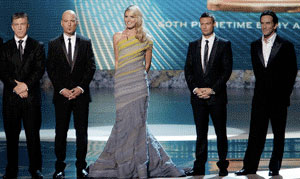
The Hollywood Reporter asks: “What makes the Emmy’s Unique?”
Seth MacFarlane, answers: “I think what makes the Emmy’s special is that no one watches them anymore.”
The AP asked, “Are the TV writers still on strike?”
USA Today: “It was hideously awful from start to harried finish, dragged down by five amateurish reality anchors who would have been unwelcome as guests, let alone hosts.”
On MediaBytes, I said, “It was about the most unfortunate show opening in recent memory.”
Pundits and critics universally panned the show, and for good reason — not only did the show fail to entertain, it just plain failed. The one thing the 2008 Primetime Emmy’s did manage to accomplish was to score the lowest ratings in Emmy history. Oh, and it also insulted the intelligence of nearly everyone who tuned in. Luckily, not too many people were insulted as the show only drew 12.3 million viewers for a 3.8 rating and a 9 share of the coveted 18-49 demographic. The ratings were so dismal that they actually made this years Oscars, which received its lowest rating since 1974 (18.7/29), 32 million viewers, seem like it got a colossal number.
I don’t think I have ever seen anything like the opening of this show. Five reality show hosts stood on stage for the better part of 12 minutes and did absolutely nothing. The climax (if you can call it that) featured William Shatner running up from his seat in the audience to help Tom Bergeron rip off Heidi Klum’s break-away costume. She is a beautiful woman (who should never be allowed to speak English out loud on stage), but the routine tanked like the Ty-D-Bol man of yesteryear. Ah yes, the old rip the clothes off a buxom girl sketch (originally made famous by Noah and a sheep on Ark Idol during the flood!) Clearly, the audience was unimpressed. The ratings were 20% under last year’s show, which was hosted by Ryan Seacrest alone.
While the lack of entertainment and production value were front and center, what truly disturbed me was the way the show constantly tried to point out the “power of primetime television.” It began with Oprah, one of television’s most powerful and recognizable figures, proclaiming, “The power of television makes us laugh, cry and even think.” This was a thinly disguised, patronizing message to advertising executives and I can promise you it fell on deaf ears.
While ad spending on cable and syndicated television were up (8.1% and 7.2%, respectively) for the first half of this year, broadcast network television was down 6%. Major advertisers like Procter & Gamble and Ford have dramatically slashed their network television advertising budgets. (Procter & Gamble reduced their ad spending by 4.33%, while Ford cut its budget by $798 million, a 30.56% decrease in spending over 2007.)
This not-so-subliminal messaging culminated in the speech given by ATAS president, John Schaffner. It was a relentless pitch for the value of television signals transmitted from broadcast television networks to television tuners everywhere. It was as ridiculous as saying that landline telephones are somehow better for communicating than mobile phones. It was simply uncalled-for.
Primetime is a function of physiology and sociology and it is in no way related to technology. At least for now, we have enough electricity to power lights and appliances when it is dark. This means that we don’t have to go to sleep when the sun sets, nor do we need to wake up when it rises.
According to Alan Wurtzel, NBCU‘s head of research, people sleep for approximately seven hours each day, work for eight and pack 12 hours of media into the remaining nine hours. Part of that media consumption experience occurs after dinner, after homework or after putting young children to bed. It happens between 8 and 11pm most evenings. This is not only primetime for television, it is primetime for everything you can possibly do with electricity: video gaming, computing, surfing the net, etc. Pushing “primetime” broadcast television is pushing a distribution methodology that dominated the last century, not this one.
More to the point – the Emmys are supposed to honor content, creativity and execution, not the signal path to the consumer. High-quality video content can be enjoyed WIWWIWWIW (pronounced wee-wee-wee), what I want, when I want, where I want. This should not be news to anyone. And while some of the best content may be originally produced for primetime broadcast network distribution, this content can also be found on virtual private networks over the public Internet, via place-shifting technology over the public Internet, via 3G mobile networks, via broadband clouds, etc. It can also be enjoyed on really small screens, really large screens, out-of-home, on handheld devices and wireless automotive screens. There are almost no restrictions regarding where, when and how you can consume quality video content.
I hope that the Emmy folks come to grips with the fact that television, in the 21st century, is simply everywhere. Television from the Greek word tele, and the Latin word visio, literally means far-sight or far-vision. It would be great if the Emmy leadership exercised some of it for next year. ![]()
[widgets_on_pages]